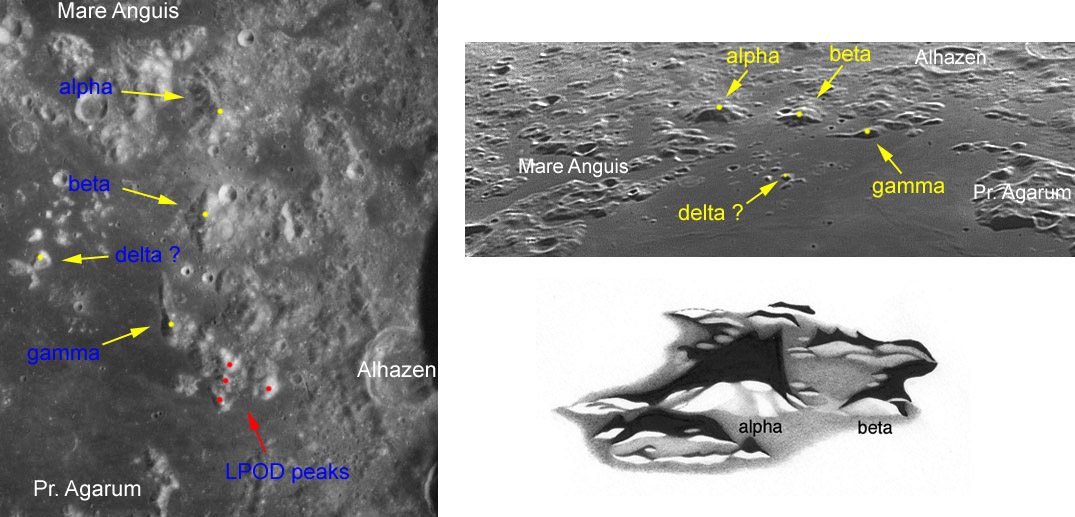
drawing by Nigel Longshaw, Manchester, UK, left and top images prepared by Jim Mosher
The Feb 16 LPOD featured a drawing by Nigel Longshaw of the peak Alhazen Alpha and a Clementine image that I added of supposedly the same area. The ever-vigilant Jim Mosher thought something didn’t look right and he was correct. In today’s LPOD the two images surrounding Nigel’s drawing were made by Jim to correctly identify the Greek-lettered peaks. The top image is an excerpt from Eric Roel’s excellent LPOD from March 30, 2006 which provides a broad terrestrial perspective which demonstrates that the small hills (between Gamma and the crater Alhazen) I identified were too inconspicuous to have been lettered by Madler in the 1830s. In fact, Alpha is the much more massive and visible peak Jim labelled to the left. The left image is a detail from Apollo AS17-M0277, which looks directly down on the northeastern shore of Mare Crisium. Jim’s red dots mark the peaks I mistaken identified, and his yellow dots with blue letters mark the correct locations. In actuallity, there is still some uncertainty about Gamma and Delta! You might wonder, how did a supposed expert like Chuck Wood make such a dreadful mistake? It started because Greek-letter designations have been unofficial since a bad decision by the IAU in the 1970s, and thus the letters don’t appear on most modern maps. This lack of clear reference material and my looking at just a small area on the Map-A-Planet Clementine image led me to the mistaken identification. And even though I am very experienced at looking a lunar images from all perspectives, I was able to mistakenly warp the high Sun vertical view of Clementine to Nigel’s low Sun oblique view. If I had taken the time to look at a terrestrial view such as Eric’s, I would (I hope) have immediately recognized the larger massifs that are the real Alpha and Beta. I can’t blame the lack of maps or Map-A-Planet for my screwup; I should have taken time to check more images. But LPOD is usually the last thing I do each night and I didn’t. I hate to make mistakes, and I’m really glad to learn the truth. Thanks, Jim!
Related Links:
The fact that the lunar literature still refers to a Greek-lettered hill demonstrates that such designations are needed. At some point the IAU needs to reverse its erroneous decision of of the 1970s, but it really can’t if there is such trouble identifying the classically labelled peaks. From time to time I will devote LPODs to clarifying the nomenclature for specific features - and maybe I’ll do it correctly.
Yesterday's LPOD: PKT & Sinuous Rilles?
Tomorrow's LPOD: A Balmy Basin
COMMENTS?
Register, Log in, and join in the comments.



